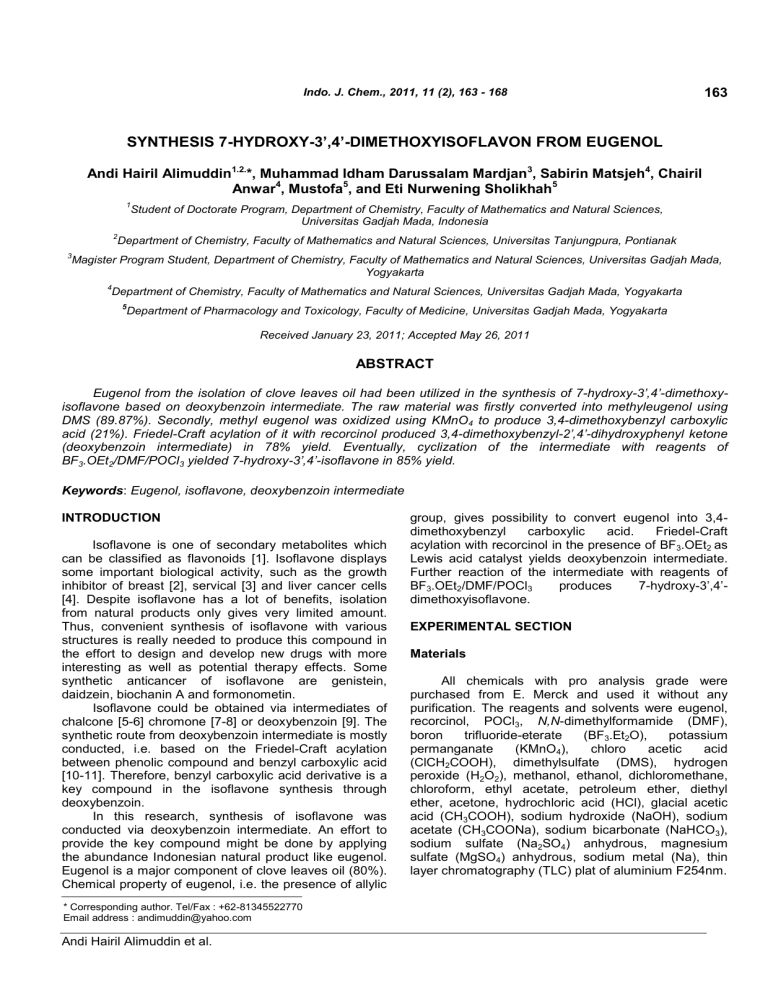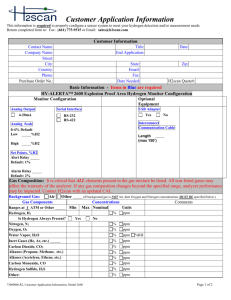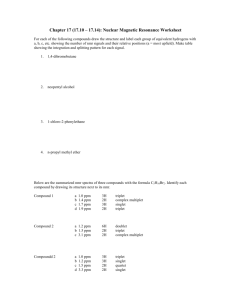synthesis 7-hydroxy-3',4'-dimethoxyisoflavon from eugenol

Indo. J. Chem., 2011, 11 (2), 163 - 168
163
SYNTHESIS 7-HYDROXY-3’,4’-DIMETHOXYISOFLAVON FROM EUGENOL
Andi Hairil Alimuddin
1.2.
*, Muhammad Idham Darussalam Mardjan
Anwar
4
, Mustofa
5
3
, Sabirin Matsjeh
4
, and Eti Nurwening Sholikhah
5
, Chairil
1
Student of Doctorate Program, Department of Chemistry, Faculty of Mathematics and Natural Sciences,
Universitas Gadjah Mada, Indonesia
2
Department of Chemistry, Faculty of Mathematics and Natural Sciences, Universitas Tanjungpura, Pontianak
3
Magister Program Student, Department of Chemistry, Faculty of Mathematics and Natural Sciences, Universitas Gadjah Mada,
Yogyakarta
4
Department of Chemistry, Faculty of Mathematics and Natural Sciences, Universitas Gadjah Mada, Yogyakarta
5
Department of Pharmacology and Toxicology, Faculty of Medicine, Universitas Gadjah Mada, Yogyakarta
Received January 23, 2011; Accepted May 26, 2011
ABSTRACT
Eugenol from the isolation of clove leaves oil had been utilized in the synthesis of 7-hydroxy-3’,4’-dimethoxyisoflavone based on deoxybenzoin intermediate. The raw material was firstly converted into methyleugenol using
DMS (89.87%). Secondly, methyl eugenol was oxidized using KMnO
4 to produce 3,4-dimethoxybenzyl carboxylic acid (21%). Friedel-Craft acylation of it with recorcinol produced 3,4-dimethoxybenzyl-2’,4’-dihydroxyphenyl ketone
(deoxybenzoin intermediate) in 78% yield. Eventually, cyclization of the intermediate with reagents of
BF
3
.OEt
2
/DMF/POCl
3 yielded 7-hydroxy-3’,4’-isoflavone in 85% yield.
Keywords : Eugenol, isoflavone, deoxybenzoin intermediate
INTRODUCTION
Isoflavone is one of secondary metabolites which can be classified as flavonoids [1]. Isoflavone displays some important biological activity, such as the growth inhibitor of breast [2], servical [3] and liver cancer cells
[4]. Despite isoflavone has a lot of benefits, isolation from natural products only gives very limited amount.
Thus, convenient synthesis of isoflavone with various structures is really needed to produce this compound in the effort to design and develop new drugs with more interesting as well as potential therapy effects. Some synthetic anticancer of isoflavone are genistein, daidzein, biochanin A and formonometin.
Isoflavone could be obtained via intermediates of chalcone [5-6] chromone [7-8] or deoxybenzoin [9]. The synthetic route from deoxybenzoin intermediate is mostly conducted, i.e. based on the Friedel-Craft acylation between phenolic compound and benzyl carboxylic acid
[10-11]. Therefore, benzyl carboxylic acid derivative is a key compound in the isoflavone synthesis through deoxybenzoin.
In this research, synthesis of isoflavone was conducted via deoxybenzoin intermediate. An effort to provide the key compound might be done by applying the abundance Indonesian natural product like eugenol.
Eugenol is a major component of clove leaves oil (80%).
Chemical property of eugenol, i.e. the presence of allylic
* Corresponding author. Tel/Fax : +62-81345522770
Email address : andimuddin@yahoo.com
Andi Hairil Alimuddin et al.
group, gives possibility to convert eugenol into 3,4dimethoxybenzyl carboxylic acid.
Friedel-Craft acylation with recorcinol in the presence of BF
3
.OEt
2 as
Lewis acid catalyst yields deoxybenzoin intermediate.
Further reaction of the intermediate with reagents of
BF
3
.OEt
2
/DMF/POCl dimethoxyisoflavone.
3 produces 7-hydroxy-3’,4’-
EXPERIMENTAL SECTION
Materials boron
(ClCH
All chemicals with pro analysis grade were purchased from E. Merck and used it without any purification. The reagents and solvents were eugenol, recorcinol, POCl
3
, N,N -dimethylformamide (DMF), acid (CH trifluoride-eterate permanganate (KMnO
4
2
COOH), dimethylsulfate (DMS), hydrogen peroxide (H chloroform, ethyl acetate, petroleum ether, diethyl ether, acetone, hydrochloric acid (HCl), glacial acetic
3
2
O
2
(BF
3
.Et
2
O), potassium
), chloro acetic acid
), methanol, ethanol, dichloromethane,
COOH), sodium hydroxide (NaOH), sodium acetate (CH
3
COONa), sodium bicarbonate (NaHCO sodium sulfate (Na sulfate (MgSO
4
2
SO
4
3
),
) anhydrous, magnesium
) anhydrous, sodium metal (Na), thin layer chromatography (TLC) plat of aluminium F254nm.
164
Indo. J. Chem., 2011, 11 (2), 163 - 168
Instrumentation
The instrumentation used in this research were laboratory glassware, magnetic stirrer, hotplate, Buchi
Evaporator R-124, vacuum pump, UV lamp, melting point apparatus (Electrothermal 9100), infra red spectrometer (FT-IR, Shimadzu FTIR Prestige 21), proton and carbon nuclear mass resonance (
1
JEOL MY6O 60 MHz and 1 H, 13
H NMR
C NMR JEOL JNM ECA
500 MHz) and gas chromatography-mass spectrometer
(GC-MS Shimadzu QP2010S).
Procedure
Synthesis of methyl eugenol
As much as 41 g (0.25 mole) of eugenol was placed in 1 L beaker, followed by the addition of 12 g
(0.3 mole) NaOH in 120 mL of aquadest. The mixture was then stirred for 20 min, poured into the separation flask and let it stand overnight to give two layers. Next, the lower layer was extracted with three portions of
20 mL of diethyl ether. The extract was removed and the remain was put into 250 mL three-necked flask equipped with magnetic stirrer, thermometer, condenser and dropping funnel which had been charged with 19.2 g
(0.15 mole) of DMS. Then, the addition of DMS was done in 1.5 h under stirring condition. The reaction mixture was heated at 110–120 °C for 3 h. After cooling, as much as 60 mL of aquadest was added and the reaction mixture was extracted with 3x20 mL of petroleum ether. The extract was collected and added with 10% of NaOH solution (15 mL). The upper layer which contains the product was washed with aquadest until neutral and dried with magnesium sulfate anhydrous overnight.
The mixture was filtered, evaporated and purified using distillation with reduced pressure. Product analysis was performed using Gas chromatography, FT-IR and
1
H-NMR spectrometers.
Synthesis of 3,4-dimethoxybenzyl carboxylic acid
The procedure was based on research done by
Gobbi et al. [12]. Into 250 mL three-necked flask equipped with magnetic stirrer, methyl eugenol
(0.02 mole), glacial acetic acid (45 mL), acetone (90 mL) and aquadest (35 mL) were placed. To the iced-cooled mixture (0–5 °C), 0.1 mole of KMnO
4 in 6 h. When all KMnO
4 was slowly added had been added (0–5 °C), the stirring was continued for 1 h. After that, the mixture was poured into 100 mL of aquadest and H
2
O
2 was applied to decolorize the mixture. The product was then extracted using dichloromethane.
Structure elucidation was conducted with FT-IR,
1
H-NMR and GC-MS spectrometers.
Synthesis of 3,4-dimethoxybenzil-2’,4’-dihydroxy phenyl ketone
In 100 mL round-bottomed flask 0.29
g
(1.5 mmole) of 3,4-dimethoxybenzyl carboxylic acid,
0.17 g (1.5 mmol) of recorcinol and 2 mL of BF O
3
.Et
2 were heated at 60–80 °C for 2 h. The cool reaction mixture was poured into the cool 12% of sodium acetate solution. The formed precipitated was filtered and recrystallized from ethanol 80%. Yield percentage and melting point of product was then determined. The product’s structure was elucidated by means of FT-IR,
1
H-NMR and
13
C-NMR spectrometers.
Synthesis of 7-hydroxy-3’,4’-dimethoxyisoflavone
Into 100 mL round-bottomed flask, 0.28 g
(0.97 mmole) of 3,4-dimethoxy benzyl-2’,4’-dihydroxy phenyl ketone and 1 mL of BF O were added. After
3
.Et
2 it had been cooled at 10 °C, as much as 0.75 mL of
DMF was added. The reaction mixture was then heated until 50 °C and 0.2 mL POCl
3 in 1.2 mL of DMF was dropped into it. Next, the reaction was continued for 4 h at 80–100 °C. The cool mixture was poured into 12% of cool sodium acetate solution to give precipitate. The precipitate was recrystallized and analyzed its melting point. Structure elucidation of product was performed using FT-IR
1
H-NMR and
13
C-NMR spectrometers.
RESULT AND DISCUSSION
Synthesis of methyl eugenol
3,4-Dimethoxybenzyl carboxylic acid is a key compound in isoflavone synthesis via the intermediate of deoxybenzoin (benzyl phenyl ketone). Its preparation could be done from eugenol, i.e. the major component of clove leaves oil which is relatively abundant in
Indonesia. The synthesis step of the target compounds was carried out as outlined in Scheme 1.
This research was begun with the alkylation of eugenol to give methyleugenol using DMS and NaOH catalyst. This step was aimed to protect the eugenol’s hydroxyl group which is susceptible to oxidation process. Methyleugenol was obtained as liquid in
89.78% yield and 93.61% purity.
Regarding to FT-IR spectrum, the broad absorption band of the hydroxyl group (-OH) from eugenol in the region of 3300 cm into methoxy group.
-1 is disappear. This indicates that the hydroxyl group has been protected
Structural characterizations of the product were done using
1
H-NMR spectrometers. Based on
1
H-NMR spectrum analysis (Table 1), it shows 5 signals depicting 5 proton types with different chemical environment. Signal A ( δ 6.8 ppm, 3 H) is the characteristic absorption of the aromatic protons. The
Andi Hairil Alimuddin et al.
Indo. J. Chem., 2011, 11 (2), 163 - 168
165
Signal
A
B
C
D
E
Integration
3
1
2
6
2
Table 2.
Interpretation of oxidation product.
Signal
A
B
C
D
Fig 1.
δ (ppm)
6.8
6.3
4.9-5.2
3.7
3.2
δ (ppm)
7.15
4.25
3.87
11
Scheme 1.
Synthesis 7-hydroxy-3’.4’-dimethoxyisoflavone from Eugenol
Table 1.
Interpretation of alkylation product
1
1
H-NMR spectrum of the
H-NMR spectrum of the
Integration
3
6
2
1
Proton Type
Aromatic H
-CH=
=CH
2
-OCH
3
-CH
2
-
Proton type
Aromatic H
-OCH
3
-
-CH
2
-
-OH-
Structure of 3,4-dimethoxybenzyl carboxylic acid
–CH= group proton (signal B) are estimated to resonate at δ 6.3 ppm, Signal C (4.9-5.2) shows the existence of protons from =CH- groups. Additionally, the presence of methoxyl (-OCH
3
) and methylene (-CH
2
) groups was indicated by signal D ( δ 3.7 ppm, 6 H) and E ( δ 3.2 ppm,
2 H), respectively.
Based on FT-IR and H-NMR analyses, it can be concluded that the synthesized product from the eugenol and dimethyl sulphate is methyleugenol.
were done using FT-IR, spectrometers.
1
H-NMR and GC-MS
FT-IR analysis shows broad absorption band in the region of 3300 cm -1 indicating the hydroxyl group
(-OH) of carboxylic group. Moreover, strong absorption at 1712.79 cm
-1 represents the carbonyl (-C=O) group.
According to
1
H-NMR spectrum (Table 2), there are 4 signals depicting 4 protons with different chemical environment. Signal A ( δ 7.15 ppm, 3 H) is the characteristic absorption of the aromatic protons.
Signal B ( δ 4.25 ppm, 6 H) shows the existence of protons from 2 methoxy (-OCH
3
) groups. Additionally, the presence of methylene (-CH
2
-) and carboxylic hydroxyl (-OH) groups was indicated by signal C
( δ 3.87 ppm, 2 H) and D ( δ 11.00 ppm, 1 H), respectively.
Further analysis using GC-MS gives ion molecular peak at m/z 196. The value shows the molar mass of 3,4-dimethoxybenzyl carboxylic acid. Based on
FT-IR, 1 H-NMR and GC-MS analysis, it can be concluded that the oxidation of methyleugenol with
KMnO
4 produces 3,4-dimethoxybenzyl carboxylic acid as the structure is presented in Fig. 1.
Synthesis of 3,4-dimethoxybenzil-2’,4’-dihydroxy phenyl ketone
Synthesis of 3,4-dimethoxybenzyl carboxylic acid
Methyleugenol was then converted into 3,4dimethoxybenzyl carboxylic acid using the oxidant of
KMnO
4
. The synthesized product was white solid with melting point of 97–98 °C. Additionally, the yield percentage was 21%. Structure analyses of the product
The key compound of 3,4-dimethoxybenzyl carboxylic acid was then used as a reactant to produced 3,4-dimethoxybenzil-2’,4’-dihydroxy-phenyl ketone. The deoxybenzoin derivative was synthesized via Friedel-Craft acylation between the key compound and recorcinol in the presence of Lewis acid likes aluminum chloride (AlCl as boron trifluoride (BF
3
3
), iron chloride (FeCl
3
) as well
). The latter’s with diethyl ether is usually employed in the isoflavone synthesis due to its abilities as catalyst and solvent [9].
Acylation reaction was performed at 60–80 °C for
2 h. The product was obtained as solid with m.p. of
171–172 °C in 76% yield. Structural characterizations of
Andi Hairil Alimuddin et al.
166
Indo. J. Chem., 2011, 11 (2), 163 - 168
Table 3.
Interpretation of
Craft acylation product
Signal δ (ppm)
A
B
C
12.57
10.69
7.9
D
E
F
G
H
I
6.9
6.7
6.3
6.2
4.19
3.7
1
H-NMR spectrum of Friedel-
Integration
1
1
1
1
1
2
1
2
6
Proton type
-OH (C4’)
-OH (C2’)
H
C6’
H
C4& C7
H
C8
H
C3’
H
C3’
-CH
2
-
-OCH
3
Table 4.
Interpretation of
Craft acylation product
δ (ppm)
202.4
164.9
164.6
148.5
147.6
133.5
127.4
121.5
113.3
112.1
111.8
108.25
102.48
55.48
55.45
43.67
13 C-NMR spectrum of Friedel-
Carbon type
C=O (C1)
C2’
C4’
C5
C6
C6’
C3
C8
C4
C1’
C7
C5
C3
C Methoxy
C Methoxy
C2(Methylene)
Fig 2.
Structure of 3,4-dimethoxy-2’,4’-dihydroxyphenyl ketone the product were done using FT-IR,
13
1
H-NMR and
C-NMR spectrometers.
IR spectrum of the product can be easily distinguished with that of reactant. The disappearance of carboxylic group absorption at 3400 cm the acylation with recorcinol has taken place.
As the IR spectrum, the
1
-1 indicates that
H-NMR spectrum of the acylation product can be readily identified from the benzyl carboxylic acid derivative. Proton’s peak in the region of ( δ ) 4-5 ppm shows the protons of methylene
(-CH
2
-) group from deoxybenzoin structure. This peak is more downfield than the methylene peak from reactant which appears in the region of 3–3.8 ppm. Others strong evidences for the success of the reaction are the occurrence of peaks in the region of ( δ ) 10–13 ppm which belong to protons from two hydroxyl groups and the disappearance of carboxylic proton peak from the reactant at ( δ ) 11 ppm. Moreover, the peaks in the region of ( δ ) 6.2–7.9 ppm with total integration of 6 protons comes from both aromatic ring A (3 protons) and ring B (3 protons). Signal I ( δ 3.7 ppm, 6 H) represents protons from two methoxy (-OCH
3
) groups
(Table 3).
Spectroscopy analysis using 13 C-NMR provides information related to carbon skeleton of the product, thus, strengthens previous analyses. According to
13
C-NMR data (Table 4) there are absorption signals in carbonyl, aryl, methoxy carbons region. Carbon of carbonyl group gives signal at 202.4 ppm. Carbon bonded to aromatic alcohol is represented by signals at
102.48 ppm and 108.25 ppm. Signal at 43.76 ppm belongs to methylene carbon. In addition, methoxy carbons appear at 55.45 ppm and 55.48 ppm. Based on FT-IR,
1
H-NMR and
13
C-NMR analysis, it can be stated that all functional groups are in full agreement with the structure of 3,4-dimethoxy-2’,4’-dihydroxy phenyl ketone (Fig. 2).
Synthesis of 7-hydroxy-3’,4’-dimethoxyisoflavone
The next steps in the isoflavone synthesis from deoxybenzoin derivative are the addition of one carbon at the position of C-2 and cyclization to yield the isoflavone. There are several reagents which can be employed to add one carbon, such as
BF
BF
3
Et
3
Et
2
2
O/DMF/methane sulfonil chloride (MeSO
O/DMF/PCl
5
[13], BF
3
Et
2
O/DMF/POCl
2
3
Cl) [9],
[13], acetic formic anhydride [14], ethyl formate/Na [15] N,N dimethylformamide dimethyl acetal refluxed with DMF or in THF [16]. In this research, cyclization of
3,4-dimethoxy-2’,4’-dihydroxyphenyl performed using POCl
3 ketone and DMF in BF
3
-Et
2 was
O which also act as the solvent. The product with m.p. of
254–255 °C was obtained in 85% yield. Product analysis was the conducted by means of
1
H-NMR and
13 C-NMR spectrometers.
1
H-NMR- spectrum of resulted product shows that characteristic peak at 4.2 ppm for methylene group in the deoxybenzoin intermediate disappears.
Additionally, the appearance of signal at 8.2 ppm represents proton of C-2 from isoflavone structure.
Those evidences indicate that the addition of one carbon atom using DMF followed with cyclization reaction has been successfully done. Signal at 6.8–7.9
with the integration of 6 comes from the aromatic protons. Moreover, peaks with chemical shift at 8.1 and
3.7 ppm belong to protons from C-5 and two methoxy groups, respectively.
Further analysis using
13
C-NMR was performed to strengthen the indication that the resulted product was
Andi Hairil Alimuddin et al.
Indo. J. Chem., 2011, 11 (2), 163 - 168
167
Table 5.
Interpretation of
1
H-NMR spectrum of 7hydroxy-3’,4’-dimethoxyisoflavone
Signal
A
B
C
D
E
F
G
H
δ (ppm)
10.82
8.33
7.9
7.18
7.10
6.9
6.8
3.7
Integration
1
1
1
2
1
1
1
6
Proton type
-OH (C7)
H
H
C2
C5
H
C6’
H
C5’
H
C2’&C8
H
C6
-OCH
3
-
Table 6.
Interpretation of
13
C NMR spectrum of
7-hydroxy-3’,4’-dimethoxyisoflavone
Carbon Type δ (ppm)
C=O
C7
C9
C2
C3’
C4’
C5
C1’
C3
C6’
C10
C6
C2’
C5’
C8
C Methoxy
C Methoxy
174
162
157
153
148.6
148.2
127
124
123
121
116
115
112
111
102
55.5
55.5
Fig 3.
Structure of 7-hydroxy-3’,4’-dimethoxyisoflavone
7-hydroxy-3’,4’-dimethoxyisoflavone. There are peaks from carbonyl, aryl and methoxy carbons in the 13 C-NMR spectrum. Carbon bonded with oxygen atom as carbonyl compound gives signal at 174.64 ppm, while as aromatic alcohol at 102.48 ppm. Carbon which is formed in the addition of one carbon and cyclization process is shown by peak at 153 ppm (C2). The process of adding one carbon atom at position methylene (-CH
2
-) of deoxybenzoin caused the peak shift carbon from 43 ppm to 123 ppm. Therefore, C2 and C3 carbon peak at a peak characteristic of isoflavone compounds. Signal at
55.52 ppm represents carbon from methoxy groups.
Based on
1
H NMR and
13
C-NMR analyses, therefore, it can be concluded that the addition of one carbon atom followed with the cyclization reaction of 3,4-dimethoxy-
2’,4’-dihydroxyphenyl ketone produces 7-hydroxy-3’,4’dimethoxyisoflavone as the product. The structure of 7hydroxy-3’,4’-dimethoxy-isoflavone is presented in
Fig. 3.
CONCLUSION
Synthesis of isoflavone from eugenol as the raw material could be conducted via several steps. There were methylation of eugenol to give methyl eugenol, oxidation of methyl eugenol to produce
3,4-dimethoxybenzylcarboxylic acid, Friedel-Craft acylation of the benzylcarboxylic acid derivative with the recorcinol followed with the addition of one carbon atom and cyclization to yield 7-hydroxy-3’,4’dimethoxyisoflavone.
Methyleugenol produced from methylation of eugenol was in 89.78% yield. Oxidation of methyl eugenol using oxidant of KMnO
4 gave its product in
21% yield. Furthermore, 3,4-dimethoxybenzyl-2’,4’dihydroxyphenyl ketone from Friedel-Craft reaction was obtained in 78% yield.
Finally, 7-hydroxy-3’,4’dimethoxyisoflavone was produced in 85.7% yield.
ACKNOWLEDGEMENT
In this opportunity, we, the authors, would thank to State Minister for Research and Technology which gave fund to this research according to the decree of
State Minister for Research and Technology, No.
194/M/Kp/X/2008, October 3 rd
, 2008.
REFERENCES
1. Liggins, J., Bluck, L.J., Runswick, S., Atkinson, C.,
Coward, W.A., and Bingham, S.A., 2000, J. Nutr.
Biochem.
, 11, 326–331.
2. Heo, M.Y., Sohn, S.J., and Au, W.W., 2001, Mutat.
Res., 488, 135–150.
3. Choi, E.J., and Kim, G-H, 2008, Phytomedicine , 15,
683–690.
4. Yeh, T.C., Chiang, P.C., Li, T.K., Hsu, J.L., Lin,
C.J., Wang, S.W., Peng, C.Y., and Jih-Hwa, 2007,
Biochem. Pharmacol.
, 73, 782–792.
5. Antus, S., Farkas, L., Gottsegen, Á., Kardos-
Balogh, Z., and Nógrádi, M., 2006, Chem. Ber.
,
109, 12, 3811–3816.
6. Horie, T., Sasagawa, M., Torii, F., Kawamura, Y., and Yamashita, K., 1996, Chem. Pharm. Bull.
, 44,
3, 486–491.
7. Barve, V., Ahmed, F., Adsule, S., Banerjee, S.,
Kulkarni, S., Katiyar, P., Anson, C.E., Powell, A.K.,
Padhye, S., and Sarkar, F.H., 2006, J. Med.
Chem., 49 , 3800-3808.
Andi Hairil Alimuddin et al.
168
Indo. J. Chem., 2011, 11 (2), 163 - 168
8. Vasselin, D.A., Westwell, A.D., Matthews, C.S.,
Bradshaw, T.D., and Stevens, M.F.G., 2006, J.
Med. Chem., 49, 13, 3973–3981.
9. Faria, T.J., Silva, L.G.F., Filho, J.D.S., Chiari, E., and Oliveira, A.B., 2005, J. Braz. Chem. Soc.
, 16,
6B, 1415–1419.
10. Singh, H., and Pratap, R., 2006, Tetrahedron Lett .,
47, 8161–8163.
11. Thoruwa, C.L., Song, T.T., Hu, J., Simon, A.L., and
Murphy, P.A., 2003, J. Nat. Prod.
, 66, 149–151.
12. Gobbi, S., Rampa, A., Bissi, A., Belluti, F., Piazzi,
L., Valenti, P., Caputo, A., Zampiron, A., and
Carrara, M., 2003, J. Med. Chem., 46, 3662–3669.
13. Sreenivasan, B., Ward, D.L., and Nair, M.G., 2000,
J. Chem. Soc., Perkin Trans. I, 567–569.
14. Liu, D.F., and Cheng, C.C., 1991, J. Heterocycl.
Chem.
, 28, 1641–1642.
15. Shriner, R.L., and Hull, C.J., 1945, J. Org. Chem.
,
10, 288–291.
16. Chang, C., Nair, M.G., Santell, R.C., and Helferich,
W.G., 1994, J. Agric. Food Chem ., 42, 1869–1871.
Andi Hairil Alimuddin et al.



